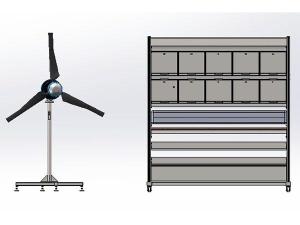Model: DLXNY-WP01
I. Description of the Wind-Solar Power Generation Training System
The DLXNY-WP01 type wind-photovoltaic complementary training system is made up of the photovoltaic power supply device, photovoltaic power supply system, wind power unit, wind power supply system, inverter and load system, and monitoring system. It features modular construction and each device and system has independent functions, allowing it to be used as a photovoltaic power generation training system or wind power generation training system.
II. Features of the Wind-Solar Power Generation Training System
1. This system uses a three-dimensional structure and standard patch board. The experiment modular is fully exposed, allowing students to learn roles quickly, and a complete closed loop control allows users an easier interaction with the system.
2. The wind-photovoltaic complementary training system uses an ARM control system, and is a high-performance control type. It can handle full-intelligent control of the battery charging & discharge and draught fan brake.
3. Off-grid inverter module boots the front end of an 8-bit MCU driving control, and front and rear axles output imported MOS FET to offer a more stable performance. We can provide a stable learning process 220V pure sine wave AC power.
4. The wind-photovoltaic complementary training system allows students to freely and easily move the device on their own, and there is no noise pollution.
III. Parameters of the Wind-Solar Power Generation Training System
Dimension: Photovoltaic power unit 1610×1010×1550mm
Wind power unit 1578×1950×1540mm
Training cabinet 3200×650×2000mm
Training content
1) Off-grid wind and solar power system planning
2) Select, install and connection of the photovoltaic cell component according to the power requirements
3) Select, install and connection of the wind generator according to the power requirements
4) Maximum power point tracking program design of photovoltaic cell modules on basis of MCU
5) Maximum power point tracking program design of wind generator on basis of MCU
6) Battery capacity matching calculation and selection
7) Battery charge and discharge parameters and protection parameter settings
8) Inverter parameters setting
9) Monitoring system configuration and operation
10) Photovoltaic power supply system debugging
11) Wind power system debugging
12) Wind and solar power generation system debugging
13) Power quality monitoring, debugging and analysis





